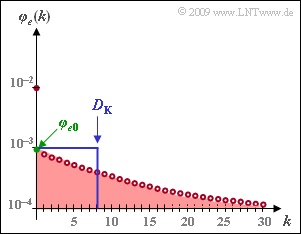Difference between revisions of "Aufgaben:Exercise 5.6: Error Correlation Duration"
| Line 1: | Line 1: | ||
| − | {{quiz-Header|Buchseite= | + | {{quiz-Header|Buchseite=Digital_Signal_Transmission/Burst_Error_Channels}} |
| − | [[File:P_ID1842__Dig_A_5_6.png|right|frame| | + | [[File:P_ID1842__Dig_A_5_6.png|right|frame|Error correlation function of the GE model]] |
| − | + | The graph shows the ''error correlation function'' (ECF) of the ''Gilbert–Elliott model'' with the parameters | |
:$$p_{\rm G} \hspace{-0.1cm} \ = \ \hspace{-0.1cm} 0.001, | :$$p_{\rm G} \hspace{-0.1cm} \ = \ \hspace{-0.1cm} 0.001, | ||
\hspace{0.2cm}p_{\rm B} = 0.1,\hspace{0.2cm} | \hspace{0.2cm}p_{\rm B} = 0.1,\hspace{0.2cm} | ||
| Line 11: | Line 11: | ||
B\hspace{0.05cm}|\hspace{0.05cm} G) = 0.01\hspace{0.05cm}$$ | B\hspace{0.05cm}|\hspace{0.05cm} G) = 0.01\hspace{0.05cm}$$ | ||
| − | in | + | in logarithmic representation. |
| − | + | This model is discussed in detail in [[Aufgaben:Exercise_5.6Z:_Gilbert-Elliott_Model|"Exercise 5.6Z"]]. In particular, the error correlation function (ECF) is also calculated in this exercise. With the auxiliary quantities | |
:$$A \hspace{-0.1cm} \ = \ \hspace{-0.1cm} (p_{\rm B}- p_{\rm M}) | :$$A \hspace{-0.1cm} \ = \ \hspace{-0.1cm} (p_{\rm B}- p_{\rm M}) | ||
\cdot (p_{\rm M}- p_{\rm | \cdot (p_{\rm M}- p_{\rm | ||
| Line 21: | Line 21: | ||
G\hspace{0.05cm}|\hspace{0.05cm} B)$$ | G\hspace{0.05cm}|\hspace{0.05cm} B)$$ | ||
| − | + | it can be written for: | |
:$$\varphi_{e}(k) = | :$$\varphi_{e}(k) = | ||
\left\{ \begin{array}{c} p_{\rm M} \\ | \left\{ \begin{array}{c} p_{\rm M} \\ | ||
p_{\rm M}^2 + A \cdot (1-B)^k \end{array} \right.\quad | p_{\rm M}^2 + A \cdot (1-B)^k \end{array} \right.\quad | ||
| − | \begin{array}{*{1}c} f{\rm | + | \begin{array}{*{1}c} f{\rm or }\hspace{0.15cm}k = 0 \hspace{0.05cm}, |
| − | \\ f{\rm | + | \\ f{\rm or }\hspace{0.15cm} k > 0 \hspace{0.05cm}.\\ \end{array}$$ |
Hierbei handelt es sich um einen Bündelfehlerkanal. Zur quantitativen Beschreibung der statistischen Bindungen verwendet man oft die Korrelationsdauer gemäß der folgenden Definition: | Hierbei handelt es sich um einen Bündelfehlerkanal. Zur quantitativen Beschreibung der statistischen Bindungen verwendet man oft die Korrelationsdauer gemäß der folgenden Definition: | ||
Revision as of 03:00, 19 September 2022
The graph shows the error correlation function (ECF) of the Gilbert–Elliott model with the parameters
- $$p_{\rm G} \hspace{-0.1cm} \ = \ \hspace{-0.1cm} 0.001, \hspace{0.2cm}p_{\rm B} = 0.1,\hspace{0.2cm} {\rm Pr}(\rm G\hspace{0.05cm}|\hspace{0.05cm} B)\hspace{-0.1cm} \ = \ \hspace{-0.1cm} 0.1, \hspace{0.2cm} {\rm Pr}(\rm B\hspace{0.05cm}|\hspace{0.05cm} G) = 0.01\hspace{0.05cm}$$
in logarithmic representation.
This model is discussed in detail in "Exercise 5.6Z". In particular, the error correlation function (ECF) is also calculated in this exercise. With the auxiliary quantities
- $$A \hspace{-0.1cm} \ = \ \hspace{-0.1cm} (p_{\rm B}- p_{\rm M}) \cdot (p_{\rm M}- p_{\rm G})\hspace{0.05cm},$$
- $$B\hspace{-0.1cm} \ = \ \hspace{-0.1cm} {\rm Pr}(\rm B\hspace{0.05cm}|\hspace{0.05cm} G) + {\rm Pr}(\rm G\hspace{0.05cm}|\hspace{0.05cm} B)$$
it can be written for:
- $$\varphi_{e}(k) = \left\{ \begin{array}{c} p_{\rm M} \\ p_{\rm M}^2 + A \cdot (1-B)^k \end{array} \right.\quad \begin{array}{*{1}c} f{\rm or }\hspace{0.15cm}k = 0 \hspace{0.05cm}, \\ f{\rm or }\hspace{0.15cm} k > 0 \hspace{0.05cm}.\\ \end{array}$$
Hierbei handelt es sich um einen Bündelfehlerkanal. Zur quantitativen Beschreibung der statistischen Bindungen verwendet man oft die Korrelationsdauer gemäß der folgenden Definition:
- $$D_{\rm K} = \frac{1}{\varphi_{e0} - p_{\rm M}^2} \cdot \sum_{k = 1 }^{\infty}\hspace{0.1cm}\big [\varphi_{e}(k) - p_{\rm M}^2 \big]\hspace{0.05cm}.$$
Der Bezugswert $\varphi_{e0}$ ergibt sich dabei durch Extrapolation der Fehlerkorrelationsfunktion in den Punkt $k = 0$. Ist wie hier der FKF–Verlauf analytisch gegeben, so kann man $\varphi_{e0}$ auch dadurch berechnen, dass man in die eigentlich nur für $k > 0$ gültige Gleichung den Wert $k = 0$ einsetzt.
Hinweise:
- Die Aufgabe gehört zum Kapitel Bündelfehlerkanäle.
- Bezug genommen wird insbesondere auf die Seite Fehlerkorrelationsfunktion des GE–Modells.
Fragebogen
Musterlösung
- Aus der Grafik auf der Angabenseite kann man $p_{\rm M} \ \underline {= 0.01}$ ablesen.
- In der Aufgabe 5.6Z wird dieser Wert auf anderem Wege berechnet.
(2) Setzt man in die untere FKF–Gleichung, die eigentlich nur für $k > 0$ gültig ist, den Parameter $k = 0$ ein, so erhält man den gesuchten Extrapolationswert.
- $$\varphi_{e0} \hspace{-0.1cm} \ = \ \hspace{-0.1cm} p_{\rm M}^2 + (p_{\rm B}- p_{\rm M}) \cdot (p_{\rm M}- p_{\rm G})\hspace{0.05cm} = 10^{-4} + (0.1- 0.01) \cdot (0.01- 0.001)=10^{-4} + 0.09 \cdot 0.009 \hspace{0.15cm}\underline {\approx 0.091 \cdot 10^{-2}}\hspace{0.05cm}.$$
(3) Nach der allgemeinen Definitionsgleichung gilt für die Fehlerkorrelationsdauer
- $$D_{\rm K} = \frac{1}{\varphi_{e0} - p_{\rm M}^2} \cdot \sum_{k = 1 }^{\infty}\hspace{0.1cm} [\varphi_{e}(k) - p_{\rm M}^2]\hspace{0.05cm}.$$
- Mit den Ausdrücken
- $$A \hspace{-0.1cm} \ = \ \hspace{-0.1cm} (p_{\rm B}- p_{\rm M}) \cdot (p_{\rm M}- p_{\rm G}) = \varphi_{e0} - p_{\rm M}^2\hspace{0.05cm},$$
- $$B\hspace{-0.1cm} \ = \ \hspace{-0.1cm} {\rm Pr}(\rm B\hspace{0.05cm}|\hspace{0.05cm} G) + {\rm Pr}(\rm G\hspace{0.05cm}|\hspace{0.05cm} B)$$
- lässt sich diese Gleichung wie folgt schreiben:
- $$D_{\rm K} = {1}/{A} \cdot \sum_{k = 1 }^{\infty}\hspace{0.1cm} A \cdot (1 - B)^k = \sum_{k = 1 }^{\infty}\hspace{0.1cm} (1 - B)^k\hspace{0.05cm}.$$
- Mit der Summenformel einer geometrischen Reihe ergibt sich daraus das Endergebnis:
- $$D_{\rm K} = {1}/{B} - 1 = \frac{1}{{\rm Pr}(\rm B\hspace{0.05cm}|\hspace{0.05cm} G) + {\rm Pr}(\rm G\hspace{0.05cm}|\hspace{0.05cm} B)} - 1\hspace{0.05cm}.$$
- Richtig ist also der Lösungsvorschlag 3.
(4) Mit ${\rm Pr(B|G)} = 0.01$ und ${\rm Pr(G|B)} = 0.1$ ergibt sich
- $$D_{\rm K} = \frac{1}{0.01 + 0.1} - 1 \hspace{0.15cm}\underline {\approx 8.091}\hspace{0.05cm}.$$
(5) Richtig ist nur der Lösungsvorschlag 1, wie in den Musterlösungen zu den letzten Teilaufgaben gezeigt wurde:
- Damit liegt die Korrelationsdauer fest, zum Beispiel:
- Mit ${\rm Pr(B\hspace{0.05cm}|\hspace{0.05cm}G)} = 0.1$ und $\rm Pr(G\hspace{0.05cm}|\hspace{0.05cm}B) = 0.01$ ergibt sich das gleiche $D_{\rm K} = 8.091$ wie mit $\rm Pr(B\hspace{0.05cm}|\hspace{0.05cm}G) = 0.01$ und $\rm Pr(G\hspace{0.05cm}|\hspace{0.05cm}B) = 0.1$.
- Aber nun ist die mittlere Fehlerwahrscheinlichkeit $p_{\rm M} \approx 9.1\%$ statt $1\%$, jeweils für $p_{\rm G} = 0.001$ und $p_{\rm B} = 0.1$.
- Auch die letzte Aussage ist falsch. Diese Aussage würde nur dann gelten, wenn $\varphi_e(k)$ linear aufgetragen wäre und nicht wie hier logarithmisch.
